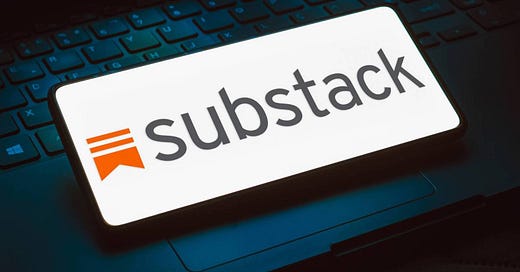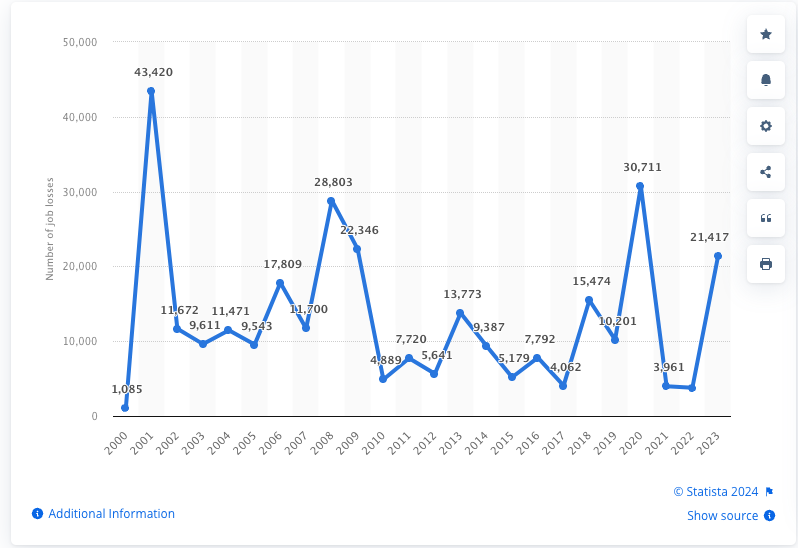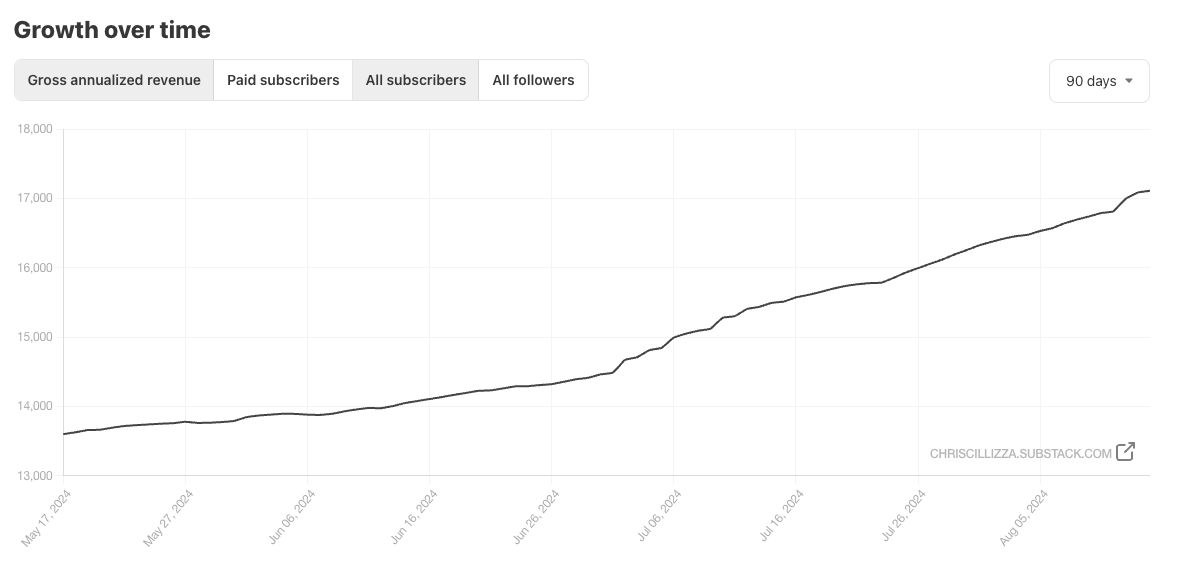When CNN laid me off at the end of 2022, my first thought was: I have to get hired by some other big media company. I didn’t care which one. Any would do.
To me, that was the only way to a) stay relevant and b) make enough money to do journalism as a full-time job.
I saw no other path.
Then I started this Substack.
This a FREE post. Please share it far and wide. But I also hope you consider becoming a paid subscriber to this newsletter. There are lots of perks — including a 30-minute one-on-one Zoom meeting with me! I promise to make it worth your money. It’s $6 a month or $60 for the entire year.
Admittedly, at first I did it for selfish reasons. I was bored doing nothing every day. (I had worked steadily since I was 16!). And I needed a way to process my thoughts about the political world, yes, but also an outlet for my struggles in dealing with being laid off and figuring out what was next.
And, to be clear, it’s not like those big media companies were knocking down my door to hire me in the months after I got laid off. If they had been, I probably would have taken the job!
I offer those caveats because I don’t want to cast myself as some visionary about the future of the news/media business. I’m not.
But what I am is a zealous convert to the age of the independent creator — in which places like Substack and YouTube play a massive and critical role. (If you don’t subscribe to my YouTube channel, do it now!)
We are now in a moment in which solo journalists (or small groups of journalists) can create a successful (and profitable) business around their work even as mainstream media companies continue to desperately grasp for a working business model.
Axios’ Sara Fischer, one of the best media reporters in the business, noticed that changing landscape — and wrote a piece on Tuesday headlined “Independent journalist era takes off.”
Here’s the critical bit from it:
Substack is on track to more than double its politics and news subscribers in 2024, executives told Axios. The number of Substack journalists in news and politics making more than $1 million has doubled over the past year — and is now in "double digits," the company says.
Journalists with big brands or unique expertise are betting there's more upside in building their own products and audience relationships right now than freelancing or joining another potentially volatile newsroom.
News industry cuts totaled 2,569 between January and July, up 10% from the same time last year, per Challenger, Gray & Christmas.
A boom in digital publishing tech combined with a slew of media cutbacks prompted a big wave of journalists to go independent during the pandemic.
But the trend slowed following a huge turnaround for media businesses in 2021, pegged to an unprecedented comeback in the ad market.
Today, industry instability, combined with product improvements at independent publishing platforms like Substack, has made independent ventures viable for a wider array of journalists.
As Simon Owens, another terrific media reporter and thinker, wrote of Sara’s piece: “If you look back to a decade ago, how many political columnists/journalists were making north of $1 million per year? The Creator Economy is unlocking the pent-up value that many star journalists created for the media outlets they previously worked for.”
Before I go into some depth on why Substack works — and why I think it and YouTube really represent the future (or at least a future) of journalism — I think it’s worth spending some time on the problems afflicting mainstream media.
Put simply: It’s a terrible business.
The Original Sin
There’s lots of reasons for that but at root the issue, to me, is this fundamental conundrum: It costs a lot of money to gather, synthesize and present news/information/content AND people are simply not habituated to paying for said news/information/content.
The original sin of this era of journalism was committed back in the early 2000s (or late 1990s) when media organizations started to put their content online. With notable exceptions — the Wall Street Journal being the most obvious — these media companies didn’t charge for their content.
At about the same time, Apple unveiled the iTunes store. It was a revelation. You could buy virtually any song, legally, for 99 cents. The price point was low enough that it felt like nothing to buy a song — or 10 songs.
And what that decision to charge for music did was get people used to the idea of paying for it. Now, no one bats an eye when Spotify or Apple Music charges a monthly subscription fee.
Journalism didn’t do that. People got used to getting news content online for free. And by the time news publishers realized they needed to start charging for content — because, again, covering the news ain’t cheap — it was too late. People balked. Why should they pay for something they had always gotten for free??? (A newspaper print subscription was never free…but I digress.)
What that mistake has led to is this: Newsrooms — none of them — have the financial means to support the sort of massive news-gathering operation that once defined the industry.
To be clear: Mainstream media isn’t going to suddenly disappear. CNN will continue to exist. Ditto the New York Times. And the Washington Post.
But what will continue to happen is this:
They will continue to make layoffs
The people who remains at these companies will make less money
The ability of any news organization to cover the entire globe (or close to it) will continue to shrink
You’ve already seen this happening. Axios, one of the supposed success stories in this new age of media, just announced layoffs. Last month, CNN announced it was making another round of layoffs. Washington Post publisher Will Lewis told his staff that the company lost $77 million in 2023 and that the time had come to start doing things very differently.
In 2023 alone, more than 20,000 media jobs were lost.
And, here’s the even worse news for mainstream media: I don’t see a light at the end of the tunnel. I supposed advertising revenue could somehow soar. Or lots and lots of people could either decide they need to become paid subscribers to big media publications or start watching cable TV again.
But, I doubt it. Last July, for the first time ever, Nielsen found that linear TV accounted for less than half of all TV watching in America. And in 2023, CNN and Fox News both saw their audiences decline by 20% year-over-year. (MSNBC’s audience rose 2%).
I don’t know how you reverse those consumption habits. And, as far as I can tell, no one else in mainstream media does either. The dirty little secret of the news business is that there is no dirty little secret. There’s no magic wand to wave. No secret sauce.
Why Substack?
Which brings me to Substack and other places like it that cater to independent creators. And my own experience building something on both this platform and YouTube.
The obvious question, it seems to me, is that if I believe that the paid models of big mainstream media operations aren’t working (and aren’t likely to work) then why would I believe Substack, which also works off a subscription model, will?
Good question, observant reader!
I have two answers to it — one editorial, one financial.
Editorial first. I think what consumers of content — especially news content — crave these days is context and community.
On the context front: You can get “What Kamala Harris is doing today” in a zillion places on the web. But it’s not everywhere that you can find someone telling you their informed take on WHY Harris is doing what she is doing. And what she will likely do next.
On the community front: Want to take a guess on which sorts of pieces drive the most paid subscribers to this newsletter? It’s NOT the political ones. It’s the ones where I write about more personal things — from my quest to find faith to the challenges of male friendship to why I love independent bookstores.
People subscribe to this newsletter — and, anecdotally to other Substacks — not because of any one particular piece of content (I am not selling a widget you can’t find anywhere else — but because of a connection they feel to me. It’s personal.
And it’s very hard to make a personal connection when you are a giant media company. Like, you may value the Washington Post or CNN but do you feel personally connected with them — to the point where you say “Yes, I want to spend my own money on making sure they can continue to do what they are doing”? Probably not.
Now, the financial piece.
The reality of any of these big media companies is that they have a LOT of costs. To cover those costs (and maybe even make money!), they have to have a massive number of people not just consuming their content but paying for it. Like, a MASSIVE number.
That’s not true for us individual creators. Look, I’d love to have 1 million subscribers! Or 250,000 paid subscribers! But I don’t need anywhere close to that many to make this whole thing [gestures around wildly] work.
Ditto YouTube. I’d love to be “Mr. Beast” (or at least have his 309 million subscribers) but my 35,000 subscribers (and growing) is workable for me!
Of course — if I am being candid — I am not where I need to be, financially, yet. I need to keep growing — especially among paid subscribers on Substack. (I am now at 3,246 paid subscribers.)
But, the chart is moving up and to the right. And I am not sure how many major mainstream media outlets can say the same.
So What
The point here is not that the independent creator life — or platforms like Substack — are perfect. It isn’t. And they aren’t. This stuff is hard work — I work WAY harder than I did at either CNN or WaPo — and the financial rewards are always slower (and smaller) than you’d like them to be.
But what Substack and YouTube and other independent creator platforms like them represent to me is hope. Hope that a path exists — or will exist — that lets me and journalists like me continue to do what they love (and what they’re good at). That journalism isn’t dead or dying but rather transforming into a model built around individuals rather than big companies.
All of this, of course, only works if you decide to support me in what I am building here. I know you have lots of pulls on your money. And that some of you simply cannot become paid subscribers.
But if you have been wavering about whether to invest in me or not, I hope this post convinces you that if you do become a paid subscriber you are not only helping me continue to do what I love but you are helping lead the way to a viable future for media more generally.
Thanks for reading. And thanks for considering becoming a paid subscriber.







I agree you are doing great. The problem with me is that if you like quite a few journalists it can get kind of expensive pretty fast at $6 a month for each. Not sure what the answer is - just be very selective on your subscription choices I guess.
Content creators rely on the big news organizations to do all the hard work of reporting and determining the news of the day. In conjunction, most independent creators provide commentary and analysis on that predetermined news cycle.
The problem is that if all the MSM went dark, content creators wouldn't have anything to say, as individually they do not have enough resources to actually do real reporting. Not to knock the hard working individuals on Substack and it's siblings; it is just that without MSM resources, we will all be less informed, and there would be far fewer independent content creators as a result.